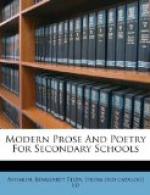The Age of Fable (chapters 22 and 23) Thomas Bulfinch
The Story of the Greek People Eva March Tappan
Greece and the Aegean Isles Philip S. Marden
Greek Lands and Letters F.G. and A.C.E. Allinson
Old Greek Folk Stories J.P. Peabody
Men of Old Greece Jennie Hall
The Lotos-eaters Alfred Tennyson
Ulysses " "
The Strayed Reveller Matthew Arnold
A Song of Phaeacia Andrew Lang
The Voyagers (in The Fields of Dawn) Lloyd Mifflin
Alice Freeman Palmer George Herbert Palmer
See the references for Moly on p. 84, and for Odysseus on p. 140.
ODYSSEUS
GEORGE CABOT LODGE
He strove with Gods and men
in equal mood
Of great endurance:
Not alone his hands
Wrought in wild
seas and labored in strange lands,
And not alone
his patient strength withstood
The clashing cliffs and Circe’s
perilous sands:
Eager of some
imperishable good
He drave new pathways
thro’ the trackless flood
Foreguarded, fearless,
free from Fate’s commands.
How shall our faith discern
the truth he sought?
We too must watch
and wander till our eyes,
Turned skyward
from the topmost tower of thought,
Haply shall find the star
that marked his goal,
The watch-fire
of transcendent liberties
Lighting the endless
spaces of the soul.
SUGGESTIONS FOR STUDY
Read the poem through. How did Ulysses strive with gods and men? Why can it be said that he did not labor alone? Look up the story of Circe and her palace.[10] What was the imperishable good that Ulysses sought? What does his experience have to do with our lives? What sort of freedom does the author speak of in the last few lines?
This verse-form is called the sonnet. How many lines has it? Make out a scheme of the rhymes: a b b a, etc. Notice the change of thought at the ninth line. Do all sonnets show this change?
EXERCISES
Read several other sonnets; for instance, the poem
On the Life-Mask of
Abraham Lincoln, on page 210, or On First Looking
into Chapman’s
Homer, by John Keats, or The Grasshopper and
the Cricket, by Leigh
Hunt.
Notice how these other sonnets are constructed. Why are they considered good?
If possible, read part of what is said about the sonnet in English Verse, by R.M. Alden or in Forms of English Poetry, by C.F. Johnson, or in Melodies of English Verse, by Lewis Kennedy Morse; notice some of the examples given.




